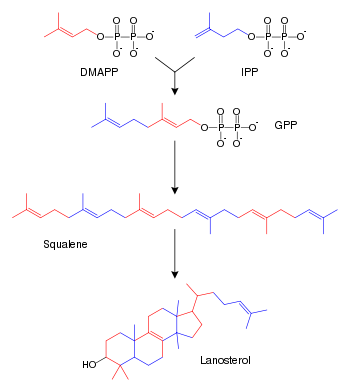Steroid
- This article is about the chemical family of steroids. For the performance enhancing substance, see Anabolic steroid.
A steroid is a terpenoid lipid characterized by a carbon skeleton with four fused rings. Different steroids vary in the functional groups attached to these rings. Hundreds of distinct steroids are found in plants, animals, and fungi. All steroids are derived either from the sterol lanosterol (animals and fungi) or the sterol cycloartenol (plants). Both sterols are derived from the cyclization of the triterpene squalene.[1]
Origin
Steroids include estrogen (U.S spelling) or oestrogen (UK spelling), progesterone and androgen. Oestrogen and progesterone are made primarily in the ovary and in the placenta during pregnancy and testosterone in the testes. Certain neurons and glia in the central nervous system (CNS) express the enzymes that are required for the local synthesis of pregnane neurosteroids, either de novo or from peripherally derived sources.
Classification
Taxonomical/Functional
Some of the common categories of steroids:
- Animal steroids
- Insect steroids
- Ecdysteroids such as ecdysterone
- Vertebrate steroids
- Sex steroids are a subset of sex hormones that produce sex differences or support reproduction. They include androgens, estrogens, and progestagens.
- Corticosteroids include glucocorticoids and mineralocorticoids. Glucocorticoids regulate many aspects of metabolism and immune function, whereas mineralocorticoids help maintain blood volume and control renal excretion of electrolytes.
- Anabolic steroids are a class of steroids that interact with androgen receptors to increase muscle and bone synthesis. There are natural and synthetic anabolic steroids. These are the steroids used by athletes to increase performance.
- Cholesterol which modulates the fluidity of cell membranes and is the principle constituent of the plaques implicated in atherosclerosis.
- Insect steroids
- Plant steroids
- Phytosterols
- Brassinosteroids
- Fungus steroids
- Ergosterols
Structural
It is also possible to classify steroids based upon their chemical composition. One example of how MeSH performs this classification is available at Wikipedia:MeSH D04#MeSH D04.808 --- steroids.
External links
- Michael W. King's Medical Biochemistry. Steroids and retinoids are both terpenes which are hydrophobic, pass through cell membranes and bind to intracellular receptors. However, retinoic acid is not a steroid because is does not have the defining ring structure. See: Steroids and Related Hydrophobic Molecules.
- "Biochemistry" by Jeremy M. Berg, John L. Tymoczko and Lubert Stryer (2002) W. H. Freeman and Co. steroid topics in this
ReferencesISBN links support NWE through referral fees
- Agis-Balboa RC. et al. (2006). "Characterization of brain neurons that express enzymes mediating neurosteroid biosynthesis". Proc Natl Acad Sci U S A 103, 14602-14607. PMID 16984997
- Belelli D. and Lambert JJ. (2005). "Neurosteroids: endogenous regulators of the GABAA receptor". Nature Reviews Neuroscience 6, 565-575. PMID 15959466. Review
- Pinna G. et al. (2005). "Fluoxetine and norfluoxetine stereospecifically and selectively increase brain neurosteroid content at doses that are inactive on 5-HT reuptake". Psychopharmacology (Berl) 186, 362-372. PMID 16432684. Review
- Dubrovsky BO. (2005). "Steroids, neuroactive steroids and neurosteroids in psychopathology". Prog Neuropsychopharmacol Biol Psychiatry 29, 169-192, PMID 15694225. Review
- Mellon SH. and Griffin LD. (2002) "Neurosteroids: biochemistry and clinical significance". Trends Endocrinol Metab 13, 35-43. PMID 11750861. Review
| |||||||||||||||||||||||||||||||||||||||||||||
Credits
New World Encyclopedia writers and editors rewrote and completed the Wikipedia article in accordance with New World Encyclopedia standards. This article abides by terms of the Creative Commons CC-by-sa 3.0 License (CC-by-sa), which may be used and disseminated with proper attribution. Credit is due under the terms of this license that can reference both the New World Encyclopedia contributors and the selfless volunteer contributors of the Wikimedia Foundation. To cite this article click here for a list of acceptable citing formats.The history of earlier contributions by wikipedians is accessible to researchers here:
The history of this article since it was imported to New World Encyclopedia:
Note: Some restrictions may apply to use of individual images which are separately licensed.
